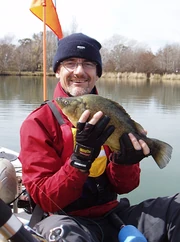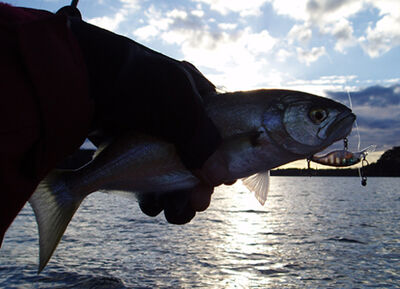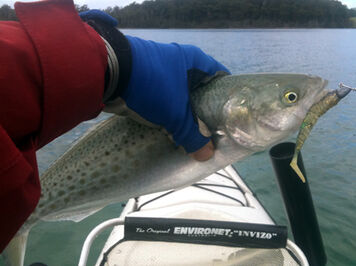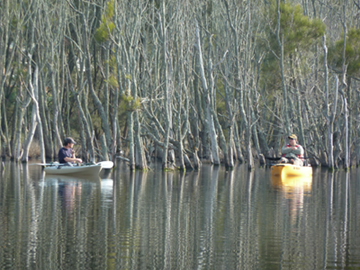Don’t Believe the Hype
The Lazy Yakker’s Guide to Catching Fish
If you read enough fishing articles you can end up thinking that angling should blend the lofty heights of art, science and technology. Luring a freshwater native from the murky depths demands a falling barometer, a rising water level and the willingness to sacrifice $300 of lures to the log gods in order to catch a single fish destined only for release. To catch a

Golden Perch caught trolling a Predatek Micro-Min in Lake Burley Griffin.
kingfish, you need to drill more holes than Willy Wonker’s dentist for the mounting of a 256 colour, 4 beam sounder, GPS, downrigger and live bait tube. You then need to get up at half past yesterday, use a $30 jig to hunt down a $5 squid, fumble the shark shield through a scupper, pucker up and paddle onward through the darkness, swell and seas in the hope of being assaulted by a hoodlum. Even to catch a humble bream you must ply the pinnacle of Japanese polymer technology, a line weight that would succumb to the mass of an Orb spider, a computer program matching moon, sun and a rising Uranus, and the ability to read the entrails of a chicken spread forth across a rack filled estuary at dawn. What hope do we have?
But many of us aren’t after the fish, merely a fish. This is especially true to those new to kayak fishing, where fishing is more the icing on the cake of the kayaking experience. A barometer is as relevant to us as ground effects are to a Sigma station wagon. This article concentrates instead on how you can luck upon your first kayak fish or (if you’re as lazy as I am) your hundredth.
Bare Essentials
So what do you need to catch a fish from a kayak? Not much really. You need a kayak obviously. This doesn’t need to be a specialised fishing kayak, just a kayak, canoe or even a ski. A sit on top type is more idiot proof as it can’t be swamped. In still water close to shore, a sit in kayak, even one without a spray skirt, is more than adequate as a starting point.
A paddle is another obvious essential. This seems a pointless statement except to those that have left it in the garage. To avoid such disappointment, I leave all my kayaking gear in a dedicated space and make sure that space is empty before I jump in the car. A paddle leash is also a good idea if you don’t have a backup (like pedal power), but if your first few trips are in calm weather then you can do without. Don’t get complacent however as few people can swim as fast as a wind-blown kayak.
In my opinion a PFD is essential, even more so for a beginner. Yes, they’re expensive, somewhat restrictive and hot. Get over it! New regulations mandate them in most situations in many states. They also provide pockets for other essentials. My PFD always contains a sharp knife, a whistle, sunscreen, a mobile phone in a dry bag and backup fuel in the form of Power Bars. My PFD also has a slot in the back for a water bladder. If yours doesn’t, then consider a Camelback or a similar backpack style hydration bladder. That way, if you are separated from your kayak you should have enough on you to survive for a while, call for rescue, or get back to the car on foot.
Clothing is up to you, but be warned. Any skin exposed to the sun will be toast. Pay special attention to wrists and ankles as long clothing can still leave these parts exposed and utterly annihilated within hours.
Tackle
OK now for the interesting stuff. A rod and reel are the norm, but don’t discount the humble handline. The whole point of kayak fishing is that you can reach areas that are beyond casting distance to from shore. You don’t really need to cast at all. Kayak fishing provides the mobility to handline lures. A lack of a rod and reel should be no inhibition to catching fish.
If you do have a rod then anything short of 8 feet is OK. Anything longer than this makes it really tricky to reach a tangled rod tip, especially in a short kayak. The best may not be the best to start with. Carbon fibre has a nasty habit of snapping if ‘high sticked’. This occurs when you lift the tip too high with the line straight down, bending the tip through 180 degrees. Since this is precisely what you do when trying to coerce your prize catch to the side of a kayak, then your precious custom built 2kg carbon fibre may best be left at home for the first few trips. A cheap rod, with a solid glass tip may be the perfect beginner weapon. I still use them, which probably says more about me than rods.
If you do need to buy a rod, then choose a length and stick to it. Anything between 5 feet and 8 feet will do. I use 7 foot rods as I have a long kayak and this lets me pass the line around the bow. Whatever the length, it’s best to have all your rods the same length so that they can be passed over one another when trolling or fighting fish. This trick is best avoided altogether when starting out. Just use one rod. You will find tip tangles and re-threading runners sufficiently frustrating to start with.
When it comes to reels, don’t skimp. If you have a $30 reel then use it, but don’t expect it to last long. Your reels will get wet when kayak fishing. No matter how hard you try, they will take a dip either with you or independently. The classic situation is to have the base of the rod fa

The Shimano Sedona is great for fishing the fresh, but just doesn't stack up to the corrosion of ocean yak fishing.
ll off the kayak when untangling the tip or re-threading runners. If it’s salt water, then you can pretty much say goodbye to that discount reel. A $100 reel will simply cost you more to replace. The price bracket for kayak reels will typically start at around $150. I have a Shimano Stradic (around $200) and a Shimano Sedona (around $130). The difference is like silk and ... well ... ugly green corrosion. I won’t buy anything less than Stradic quality in the future. The rest is false economy.
Thread that reel with anything you like. All that talk of gel spun braid, fluorocarbon and the thirty eight different ways of joining them is superfluous if you have a reel already full of monofilament (once referred to simply as fishing line). Choose something that doesn’t knot when you breathe on it and that doesn’t require a pair of diamond edged scissors to cut free from.
A paddle leash may be optional, but a rod leash is not. Anything will do, but nothing won’t. Your $200 Stradic reel may remain bright and shiny, but this will do little to console you once it’s thirty metres down and your mates start channelling Beyonce empathetically. “If you liked it then you should have put a string on it”.

The Ecogear sx40 strikes again, this time a chopper Tailor falls victim.
Lures
I rarely fished with lures before I started kayak fishing. Now I rarely fish with bait. Gathering or buying bait somehow seems to restrict the freedom that kayak fishing provides. Spending prolonged periods in intimate proximity to pilchards also does something to the ambiance.
I have hundreds of lures of which I use about three on any trip. If you prefer to collect a feed than coloured plastic then two hardbodied lures and a packet or two of soft plastics should get you sorted. If I was given such a rational restriction and my life depended on catching a feed, I would choose an Ecogear sx40F (one of the silver varieties), a Predatek MinMin (black and silver), a packet of Squidgy fish (black and gold) and a packet of Gulp sandworms (camo). These would account for perhaps 80% of my kayak fish. If I had to buy one packet of jig heads they’d be ¼ ounce, heavy duty number 4. This is on the principal that a small hook can catch a large fish, but not vice versa. Such a minimalist collection negates the need for a tackle box.
Tactics
Tactics (if you can call them that) consist of two words; trolling and drifting. That’s what kayaks do. They move, whether you want them to (trolling) or don’t (drifting). The best kayak fisherman, those that trawl through a whole rack of fishing magazines each month to tune their technology and tactics, still catch a lot of good fish while not trying. They just rarely talk about it and never write about it.
Drifting is relaxing, peaceful and so often rewarding. Tacticians will tell you to cast a lightly weighted soft plastic ahead of the drift, let it slowly drop to the bottom while keeping contact, pause, caress the rod tip up once or twice, then let the plastic drop again. When the plastic is below the kayak, retrieve and re-cast. That’s a lot of work when all you want to do is lay back and watch the wildlife. I usually relent within 15 minutes of no success and do the opposite for hours.
Find a wind or tide driven drift. Slow is best but fast will still work. I like a depth of 1 to 5 metres. Any shallower and you will likely disturb the fish as your hull drifts over them. Any deeper and it can be hard to hold bottom. A sand or mud bottom is ideal as weed and snags can be incompatible with the desired lack of effort.
Choose a jig head from your one and only packet, heavy enough to hold bottom, and thread your Gulp sand worm or Squidgy fish from the head to the length of the hook. The plastic should be straight, but don’t worry too much if it isn’t. Cast or lower the lure behind the kayak, and let out 20 to 30 metres of line. That way any fish you disturb as you drift over them will have time to forget and return before the lure arrives. You can use your rudder (if you have one) to keep the kayak at just the right angle and stop it spinning. Hold the rod in hand and occasionally give it a twitch or two while you look at the circling eagles. Success may be signalled by as little as a gentle weight (flathead) or a veracious attack (bream). Don’t be afraid to strike, that just imparts more action and interest. If you do rustle up some interest, then take a mental note of the spot and drift over it again.
At the end of the drift, reel in the line and paddle or pedal back to the start. Try the same drift if you are successful or a slightly different line if you aren’t. You may not succeed, but you can always say (with confidence and conviction) that you didn’t try very hard. If you do succeed, then lie about how hard you had to work.

A squidy fish accounts for an Australian Salmon in Wagonga Inlet.
Trolling requires a little more work, but only by a few calories. It’s a little trickier than drifting as you can’t hold a rod in your hand and paddle at the same time. Clenching the rod between your thighs is an option (rod leash essential), but it is a tad uncomfortable. The solution is either a rod holder or a pedal system. Interestingly, most pedal kayaks have inbuilt rod holders to optimise laziness. Many paddle only kayaks also have rod holders. If you don’t have a rod holder on your paddle only kayak then you can still fish, but you’ll probably install one after the thigh chafing gets the better of you.
Trolling is where paddle kayaks have a natural advantage. The paddle strokes impart speed variations that make lure action more irresistible. If you pedal, then a similar variation can be achieved by holding the rod in your hand and imparting action with your wrist. Either can be achieved while taking in the mirror like reflections, eating cake or discussing more sophisticated tactics that you read in the latest fishing magazine with you equally lazy mates. Best of all, slower is better, the bare minimum effort necessary to impart lure action.
Lure depth is important when trolling. Trolling at 3 metres in 10 metres of water is likely to be as effective as trolling from a plane. In an estuary or lake, your lure will be most effective within a metre or so of the bottom. This in no way mandates a sounder. Let the lure be your sounder. If you don’t occasionally feel the lure bump the bottom or snag some weed then you should move closer to shore. If you can feel it tunnelling through the mud then head for deeper water. Most lure packaging will tell you the maximum lure depth. The MinMin will run deeper than the sx40. This will allow you the option of changing lures rather than going to the effort of paddling to a different area. Following the edge of weed beds or parallel to drop-offs can increase the percentages.
There is effort free value in monitoring lure action. If you hold the rod in your hand (pedalling) then you should feel the lure vibrate. If the rod is in a holder, then you should be able to see the action in the rod tip. A loss of action will generally mean the lure has picked up some weed or other detritus rendering it useless. A flick of the rod will often dislodge the offender. If not, then you will have to (egad) wind the handle of the reel, bring the lure to the kayak and clean it.
Trolling can be responsible for the capture of countless species. I have caught flathead, snapper, tailer, Australian salmon, garfish, leatherjackets, pike, redfin and even squid on the same sx40. In fact, one of the few fish I haven’t caught on this specialised bream lure is a bream. Instead I caught my PB bream while trolling a popper. Go figure!

Why expend effort when you can drift around in places like this?
In Summary
Fine tuning your tactics is undoubtedly the road to more productive fishing. But if you judge your success by reward for effort, then reduced effort can be as valuable as a high reward. This is especially true if you believe the effort involved in kayak fishing to be a barrier. It isn’t, or at least doesn’t have to be. A kayak, a paddle, a PFD with a few essentials, a rod, a reel and a leash, and a handful of lures is all you need. A lack of knowledge, tactics and techniques is no impediment to catching fish. A lazy drift or a mindless troll can (and usually will) be rewarded with something. If something is all you are after while you appreciate the main game of spending a peaceful time in the great outdoors, then go get some. You don’t need to write articles on kayak fishing to be a kayak fisherman; you just need to drag a line behind you. It saves all that frustration when your neural network filled with tactics, technology and trickery still gets outsmarted by a cold blooded brainstem.